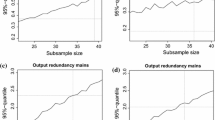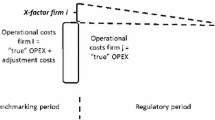Abstract
Rewarding regulated firms based on their relative performance requires benchmarks that reflect how performance is affected by regulation. This paper demonstrates how parametric and nonparametric efficiency measures can be employed to produce benchmarks that account for the effects of regulation. We apply measurement techniques to an eleven-year panel of 20 U.S. interstate natural gas transmission companies and use our benchmarking measures to distinguish firms that perform well owing to a superior management of technology from firms that perform well owing to the effective management of the regulatory mechanism.
Similar content being viewed by others
References
Aivazian, Varouj A., Jeffrey L. Callen, M. W. Luke Chan, and Dean C. Mountain. (1987). “Economies of Scale Versus Technological Change in the Natural Gas Transmission Industry.” Review of Economics and Statistics 69(3), 556–561.
Atkinson, Scott E., and Robert Halvorsen (1984). “Parametric Efficiency Tests, Economies of Scale, and Input Demand in U.S. Electric Power Generation.” International Economic Review 25(3), 647–662.
Banker, R. D., A. Charnes, and W. W. Cooper. (1984). “Some Models for Estimating Technical and Scale Inefficiencies in Data Envelopment Analysis.” Management Science 30(9), 1078–1092.
Board of Governors of the Federal Reserve. (1980, 1983, 1984, 1989, 1991). Federal Reserve Bulletin. Washington DC: U.S. Government Printing Office.
Callen, Jeffrey L. (1978). “Production, Efficiency, and Welfare in the Natural Gas Transmission Industry.” American Economic Review 68(3), 311–323.
Charnes, A., W. W. Cooper, and E. Rhodes (1978). “Measuring the Efficiency of Decision Making Units.” European Journal of Operational Research 2(6), 429–444.
Christensen, Laurits R., Dale W. Jorgenson, and Lawrence J. Lau. (1971). “Conjugate Duality and the Transcendental Logarithmic Production Function.” Econometrica 39(4), 255–256.
Commerce Clearing House Inc. (1978, 1981, 1986, 1987). U.S. Master Tax Guide. Chicago: Commerce Clearing House Publishers, Editions: 61, 64, 69, 70.
Färe, Rolf, Shawna Grosskopf, and C. A. Knox Lovell. (1994). Production Frontiers. New York: Cambridge University Press.
Färe, Rolf, and James Logan (1992). “The Rate of Return Regulated Version of Farrell Efficiency.” International Journal of Production Economics 27(2), 161–165.
Färe, Rolf, and James Logan (1986). “Regulation, Scale, and Productivity: A Comment.” International Economic Review 27(3), 777–780.
Färe, Rolf, and James Logan (1983). “The Rate-of-Return Regulated Firm: Cost and Production Duality.” Bell Journal of Economics 14(2), 405–414.
Farrell, M. J. (1957). “The Measurement of Productive Efficiency.” Journal of the Royal Statistical Society, Series A (General) 120(III), 253–281.
Ferrier, Gary D. (1994). “Ownership Type Property Rights and Efficiency.” In A. Charnes, W. Cooper, and A. Lewin (eds.), Data Envelopment Analysis: Theory, Methodology, and Applications, Massachusetts: Kluwer Academic Publishers, 273–283.
Fried, Harold O., C. A. Knox Lovell, and Shelton S. Schmidt. (1993). The Measurement of Productive Efficiency: Techniques and Applications. New York: Oxford University Press.
Granderson, Gerald, and C. A. Knox Lovell (1998). “The Impact of Regulation on Input Substitution and Operating Cost.” Southern Economic Journal 65(1), 83–97.
Hazilla, Michael and Raymond J. Kopp. (1986). “Systematic Effects of Capital Service Price Definition on Perceptions of Input Substitution.” Journal of Business and Economic Statistics 4(2), 209–224.
Ibbotson, Roger C., and Rex A. Sinquefield (1989). Stocks, Bonds, Bills, and Inflation: Historical Returns (1926–1987). Virginia: Research Foundation of the Institute of Chartered Financial Analysts.
Jorgenson, Dale W. (1963). “Capital Theory and Investment Behavior.” American Economic Review 53(2), 247–259.
National Association of Regulatory Unility Commissioners. (1973–1988). Annual Report on Utility and Carrier Regulation. Washington DC: U.S. Government Printing Office.
Natural Gas Supply Association. (1989). Financial Performance of Major U.S. Interstate Pipelines: 1979–1989. Washington DC.
Nelson, Randy A., and Mark E. Wohar. (1983). “Regulation, Scale Economies, and Productivity in Steam-Electric Generation.” International Economic Review 24(1), 57–78.
Office of Oil and Gas, Energy Information Administration, U.S. Department of Energy. (1977–1987). Statistics of Interstate Natural Gas Pipeline Companies. Washington DC: U.S. Printing Government Office.
Office of Pipeline and Producer Regulation, Federal Energy Regulatory Commission, U.S. Department of Energy. (various years). Cost of Pipeline and Compressor Station Construction Under Non-Budget Pipeline Certificate Authorization. Washington DC: U.S. Government Printing Office.
Office of Pipeline and Producer Regulation, Federal Energy Regulatory Commission, U.S. Department of Energy. (various years). Cost of Pipeline and Compressor Station Construction Under Natural Gas Act Section 7(c). Washington DC: U.S. Government Printing Office.
Petersen, H. Craig. (1976). “An Empirical Test of Regulatory Effects.” Bell Journal of Economics 6(1), 111–126.
Schmidt, Peter and Robin C. Sickles. (1984). “Production Frontiers and Panel Data.” Journal of Business and Economic Statistics 2(4), 367–374.
Shephard, RonaldW. (1970). Theory of Cost and Production Functions. New Jersey: Princeton University Press.
Texas Eastern Transmission Corporation. (1991). Capitalization-Rate of Return Report. Texas: Texas Eastern Company Report.
Value Line Publishing Inc. (1977–1987). Value Line Investment Survey. New York: Value Line Publishers.
Zieschang, Kimberly D. (1983). “A Note on the Decomposition of Cost Efficiency into Technical and Allocative Components.” Journal of Econometrics 23(3), 401–405.
Author information
Authors and Affiliations
Rights and permissions
About this article
Cite this article
Granderson, G., Linvill, C. Parametric and Nonparametric Approaches to Benchmarking the Regulated Firm. Journal of Productivity Analysis 12, 211–231 (1999). https://doi.org/10.1023/A:1007896105843
Issue Date:
DOI: https://doi.org/10.1023/A:1007896105843




